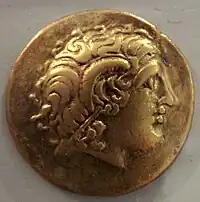The Gallitae were a Gallic tribe dwelling in the upper valley of the Bléone river (Alpes-de-Haute-Provence) during the Iron Age.
Name
They are mentioned as Gallitae (var. -tre) by Pliny (1st c. AD) and on an inscription.[1][2]
The name Gallitae appears to be based on the Celtic root gal(l)-, meaning 'power, ability', which can also be found in the ethnic names Galli (Gauls) and Galátai (Galatians).[3][2]
Geography
The Gallitae lived in the upper valley of the Bléone river, in a land later called ager Galadius in the early Middle Ages (813–814 AD).[4] Their territory was located north of the Bodiontici, east of the Sogiontii and Sebaginni, west of the Eguiturii, south of the Edenates.[5]
History
They are mentioned by Pliny the Elder as one of the Alpine tribes conquered by Rome in 16–15 BC, and whose name was engraved on the Tropaeum Alpium.[6]
References
- ↑ Pliny. Naturalis Historia, 3:20. CIL 5:7817
- 1 2 Falileyev 2010, s.v. Gallitae.
- ↑ Matasović 2009, p. 150.
- ↑ Barruol 1969, pp. 387–389.
- ↑ Talbert 2000, Map: 16 Col. Forum Iulii-Albingaunum; Map 17: Lugdunum.
- ↑ Pliny. Naturalis Historia, 3:20.
Primary sources
Bibliography
- Barruol, Guy (1969). Les Peuples préromains du Sud-Est de la Gaule: étude de géographie historique. E. de Boccard. OCLC 3279201.
- Falileyev, Alexander (2010). Dictionary of Continental Celtic Place-names: A Celtic Companion to the Barrington Atlas of the Greek and Roman World. CMCS. ISBN 978-0955718236.
- Matasović, Ranko (2009). Etymological Dictionary of Proto-Celtic. Brill. ISBN 9789004173361.
- Talbert, Richard J. A. (2000). Barrington Atlas of the Greek and Roman World. Princeton University Press. ISBN 978-0691031699.
